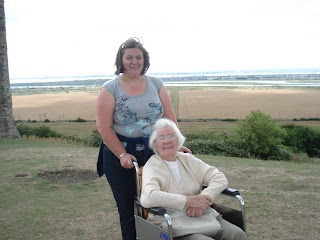 I think I may have mentioned before my general disappointment in installation art. So you might well ask, why do I keep going to look at it? Well because every so often you find something that takes your breath away. Something that is so staggeringly attractive that you can't get it out of your head. This exhibition was one of those moments and it make all the others worth while.
I think I may have mentioned before my general disappointment in installation art. So you might well ask, why do I keep going to look at it? Well because every so often you find something that takes your breath away. Something that is so staggeringly attractive that you can't get it out of your head. This exhibition was one of those moments and it make all the others worth while.
The majestic quality of these huge paper sculptures is best left described by those that know best (see below), but I can assure you that it is well worth a look. These magnificent, slowly spinning sculptural homage’s to the chalk hills so prominent to the East coast of England bring a sense of peace and tranquillity that plays a mutual respect to the surroundings in which they find themselves and leaves you with a feeling of reverence.

That these lovingly crafted and stately effigies are so willing to give up their splendour and sink into the black ink of the lagoon waiting below the chosen few only adds to the admiration I feel for the exhibit as a whole and this selfless act in turn creates a new beauty all of its own.
I would like to see inside the mind of the man that see this in his head.
So what is Fabrica? Based in an old Regency style church, next to a very good cook shop in the centre of Brighton it specialises in displaying contemporary installation art in a visually challenging backdrop. Challenging because the Church it's self it quite an installation in its own right.
According to Fabirca the gallery "Opened in March 1996 in the deconsecrated
contemporary visual art practice, with the support of South East Arts, Brighton Borough Council, The Foundation for Sport and the Arts, and Chichester Diocese.
Fabrica is a place where artists come to make new work. Fabrica supports and encourages the artists with whom it works to be adventurous and to test the boundaries of their practice. It encourages an open dialogue between artists and visitors within the gallery space and produces an integrated programme of education and audience development activity that strives to remove barriers to access, engagement and understanding."
John Grade
11 July - 31 August
Opening times
Wed-Sat 12-5.30pm
Open until 7pm Thursdays in August
Sun & Bank Holiday 2-5pm
Closed Mon & Tues
 Twin clusters of horn-like cones float down from the rafters of the gallery. One group dissolving into a mysterious pool, the other, awaiting a ceremonial end in the sea…
Twin clusters of horn-like cones float down from the rafters of the gallery. One group dissolving into a mysterious pool, the other, awaiting a ceremonial end in the sea…
This huge new sculpture created specifically for Fabrica by
Coccolithophores are invisible algae that congregate in their billions just beneath the surface of the world's oceans. When they die their protective outer casings drop to the seabed, where over time they form thick sediments on the seafloor. Around 80-110 million years ago they were responsible for forming the chalk which we now know as the
It was the eminent
Landscape is at the heart of John Grade's work. Past projects have involved travelling across the vast wildernesses of North and
More recently he completed a creative residency in the Western boglands of
His work is characterised by the meticulous crafting of sc
 ulptural objects that are then left outside - either buried, left to rot or dissolve - to let nature take its course.
ulptural objects that are then left outside - either buried, left to rot or dissolve - to let nature take its course.
His preoccupation with change and natural disintegration means his works are rarely finished, always remaining in transition and open to chance. Periodically items are brought back indoors to be exhibited, re-examined, or to be worked on again, then returned once more to the landscape as a final resting place.
Grade's drawings and sculptures have been shown extensively in galleries, museums and outdoor locations across the












































 You will be glad to know that Anna's return
You will be glad to know that Anna's return 



